
In the first half of the year, we introduced Wi-Fi 6/6E and explained the “black technology” it employs.
Following Wi-Fi 6E, the 7th generation Wi-Fi technology (also known as IEEE 802.11be or Wi-Fi 7) is about to be launched.
This will be the fastest Wi-Fi technology to date, changing the game and providing a better user experience for our daily network and online activities.
It will support and accelerate many demanding applications such as 8K video streaming, fully immersive AR/VR, gaming, and cloud computing.
This article will review the key features supported in 802.11be Release 1 and understand the benefits of Wi-Fi 7 and how it enables future connectivity.
Key Features of Wi-Fi 7
320MHz Channel Bandwidth
With the 6 GHz band opened up for Wi-Fi applications, Wi-Fi 7 supports a maximum channel bandwidth of 320 MHz in the 6 GHz band, while also supporting 20/40/80/160 MHz channel bandwidth in the 5 GHz and 6 GHz bands, and 20/40 MHz in the 2.4 GHz band. Compared to existing Wi-Fi 6/6E, just the 320 MHz channel bandwidth doubles the maximum speed of Wi-Fi 7.
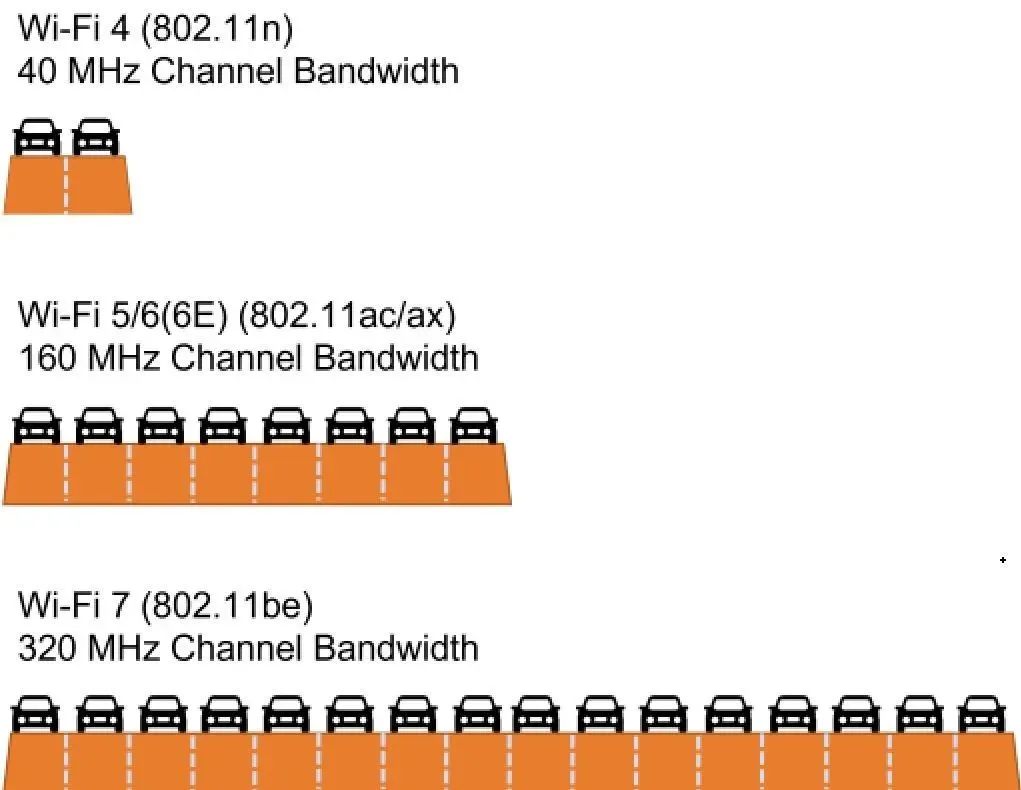
Quadrature Amplitude Modulation (QAM) is a widely used Wi-Fi modulation scheme that combines changes in amplitude and phase in mixed carriers.
Wi-Fi 6 supports up to 1024 QAM—where the constellation points on the left in Figure 2 represent 10 bits of data (symbols).
Wi-Fi 7 supports 4096 QAM—where each constellation point on the right represents 12 bits of data (symbols). In other words, each point modulated by QAM in Wi-Fi 7 can carry 2 bits more information than in Wi-Fi 6, resulting in a 20% speed increase.
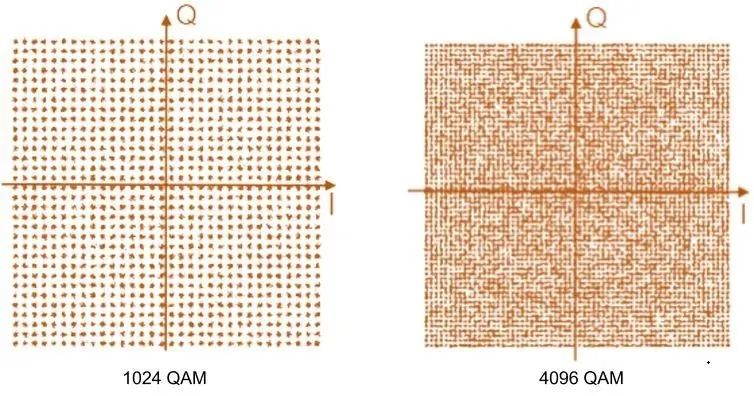
Multi-Link Operation (MLO)
Multi-Link Operation (MLO) is an important and useful feature in Wi-Fi 7.
It allows devices to send and receive simultaneously across multiple bands and channels. Similar to link aggregation or clustering in wired (i.e., Ethernet) networks, but more complex and flexible.
It creates multiple links (radio) across different bands and channels as a virtual link between connected peers. Each link (radio) can operate independently and simultaneously with other links or coordinate for optimal aggregation speed, latency, range (coverage), or power savings.
Wi-Fi 7 MLO is a MAC layer solution that can use multiple links simultaneously, transparent to upper-layer protocols and services. MLO can improve throughput, link robustness, roaming, interference mitigation, and reduce latency.
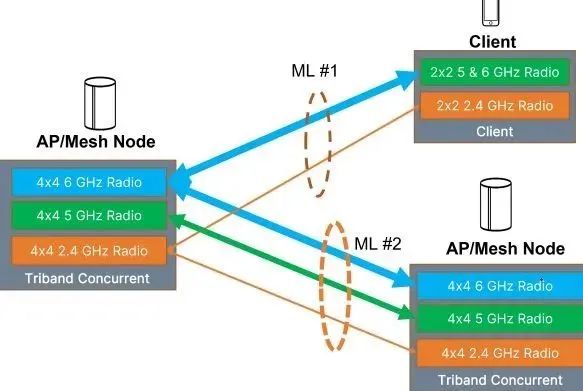
For example, in a home mesh network composed of tri-band (6GHz, 5GHz, 2.4 GHz) mesh nodes or APs, MLO can form a high-speed, low-latency wireless backbone for the home network and provide backhaul for devices connected to the mesh nodes/APs.
If each mesh node supports a 4×4 tri-band concurrent configuration, the aggregated backhaul speed can reach 21.6 Gbps. With MLO, the backhaul is also more robust and reliable. When the 5GHz link is interrupted by DFS (radar), traffic can automatically switch to the 6GHz and 2.4 GHz links without causing service interruption or QoS (Quality of Service) degradation. Compared to MLO-based backhaul in Wi-Fi 7, today’s Wi-Fi 6 and 6E mesh solutions using 4×4 radios for wireless backhaul only provide 4.8 Gbps speeds. If this link is interfered with or interrupted, the entire backhaul will be affected or interrupted, leading to QoS degradation or interruption.
When client devices (such as smartphones, laptops, etc.) support multiple wireless links, MLO creates a larger pipeline between the device and AP for higher speeds, lower latency, and greater reliability, improving the seamless roaming user experience.
Multi-Resource Unit (MRU)
Wi-Fi 7 introduces new RU resource allocation mechanisms.
In Wi-Fi 6, APs could only allocate one RU for each user (non-AP user), while Wi-Fi 7 allows multiple MRUs (resource units) to be set for a non-AP user.
MRUs further enhance spectral efficiency, providing users with more flexible bandwidth (QoS) control as needed, improving the interference resistance and coexistence capability of existing devices operating on the same band or channel.

This MRU mechanism supports Orthogonal Frequency Division Multiple Access (OFDMA) and non-OFDMA (i.e., MU-MIMO) modes.
The OFDMA mode supports small MRUs and large MRUs, allowing more flexible allocation of RUs/MRUs without complex MAC and scheduler designs.
The non-OFDMA mode provides maximum flexibility in sub-channel preamble puncturing.
For example, any 20 MHz sub-channel can be punctured within the 320 MHz bandwidth, in addition to the primary channel or 40/80 MHz channels. This allows transmissions to maximize the use of the channel spectrum in the presence of interference and provides optimal coexistence when any device operates on specific spectrum segments of the channel.
Wi-Fi 7 has many new features and improvements. These features include: preamble pulses, Target Wake Time (TWT), restricted time wave (rTWT), extended range (MCS 14 and MCS 15), etc.
Other features, such as multi-AP coordination (coordinated beamforming, coordinated OFDMA, coordinated spatial reuse, joint transmission), 16 spatial streams, and HARQ, may be supported in Release 2, which will not be covered in this article.
How Wi-Fi 7 Benefits End Users
Extremely High Throughput
Wi-Fi 7 supports blazing speeds.
Building on its predecessor Wi-Fi 6 (also known as 802.11ax), Wi-Fi 7 supports Extremely High Throughput (EHT), with raw data rates of up to 46 Gbps and 16 spatial streams defined in the standard specifications.
This is much faster than 10 Gbps Ethernet running on Cat 6/6a/7 cables. The closest access and connection technologies are Thunderbolt 3/4, USB 4, and HDMI 2.1, offering maximum raw data rates of 40Gbps or higher.
Wi-Fi 7 will support 320MHz channel bandwidth, which is double that of Wi-Fi 6.
Wi-Fi 7 also increases the QAM granularity from 1024 (1K) to 4096 (4K), resulting in a 20% speed increase compared to Wi-Fi 6/6E or Wi-Fi 5 Wave 3.
Additionally, Wi-Fi 7 doubles the maximum number of spatial streams, which in some cases can be exchanged with the number of antennas, increasing from 8 to 16. Therefore, the maximum of 9.6 Gbps supported by Wi-Fi 6/6E for 8 spatial streams increases to 46 Gbps for Wi-Fi 7 with 16 spatial streams.
At these extremely high speeds, users can achieve up to 5.8 Gbps on common devices such as smartphones and laptops using two Wi-Fi antennas (two spatial streams).
Many devices that use a single antenna can also support data rates of up to 2.9 Gbps due to strict power or form factor limitations. Users can achieve more than double the speed without paying for additional antennas or higher electricity bills, as no extra power amplifiers or front-end modules are needed—this is a paradigm shift for many future applications.
Ultra-Low Latency
Latency is another critical parameter for Quality of Service (QoS) and user experience.
It is especially crucial for real-time applications. Many multimedia applications, such as high-resolution real-time video streaming, virtual reality, augmented reality, cloud gaming, and real-time programming, require latency of less than 20 milliseconds.
Achieving such low latency in a wireless environment is not easy. For fiber access, the latency between the WAN side, modem, and cloud/server is about 10 milliseconds or slightly longer.
Considering this, the latency budget between WAN modems and endpoint client devices should be around 10ms or less for a good user experience. Wi-Fi 6 achieves 10-20ms latency.
Moreover, Wi-Fi 6E can achieve lower latency in much less contested environments. Wi-Fi 7 will help reduce latency to below 10 milliseconds, ultimately reaching a range of less than 1 millisecond with deterministic boundaries by using various tools in the 802.11be standard.
These tools include MLO, time wave transformation (TWT), and rTWT, improved trigger transmission, and eventually integrated time-sensitive networking (TSN) capabilities.
Stronger Connections
As mentioned earlier, MLO provides a dynamic mechanism to adapt connections between multiple links.
MLO can dynamically balance the transmission load between two link peers (such as APs and client devices) based on metrics such as link performance and robustness, i.e., load balancing.
If one link experiences interference or link loss (e.g., due to range), the connection can still operate over the remaining links, and the transmission can seamlessly switch from the faulty link to a good link (also known as fast failover).
MRU/RU and preamble puncturing also benefit connection robustness. For example, when a specific sub-channel or segment of the frequency of the running channel experiences interference, the AP can avoid using those interfered sub-channels or RUs/MRUs and optimize transmission based on the current environmental conditions and channel status. Furthermore, MCS 14 and MCS 15 are defined to improve signal-to-noise ratio, enhancing connection robustness as the distance between link peers increases.
Better Interference Mitigation and Coexistence
Wi-Fi 6 and Wi-Fi 6E have enhanced many features for reducing interference and coexisting with existing devices based on Wi-Fi 5.
Wi-Fi 6 provides a more flexible sub-channel puncturing mode and can utilize RUs in OFDMA mode to avoid finer-grained interference, detailed down to 2 MHz (with a minimum RU of 26 tones).
Wi-Fi 6E supports automatic frequency coordination (AFC) for coexistence with existing devices.
Wi-Fi 7 features MRU and maximum flexible preamble puncturing, supporting all possible sub-channels and high-resolution puncturing modes in both OFDMA and non-OFDMA (MU-MIMO) modes, providing better interference mitigation and optimal QoS for different types of traffic.
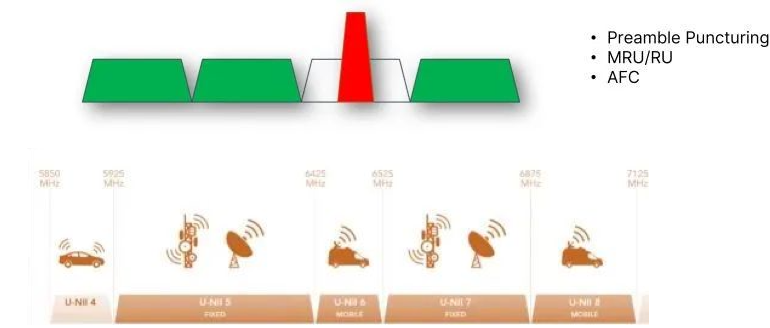
Better Roaming User Experience
MLO also improves the seamless roaming user experience.
It provides built-in roaming enhancements defined in the 802.11be standard. For example, when a device moves away from an AP, MLO retains the ML (multi-link) connection between the AP and the device, allowing it to operate automatically on the 2.4 GHz band without needing to switch bands.
Conversely, if the device approaches the AP, MLO can automatically and dynamically operate on the 5 GHz and 6 GHz bands for better performance.
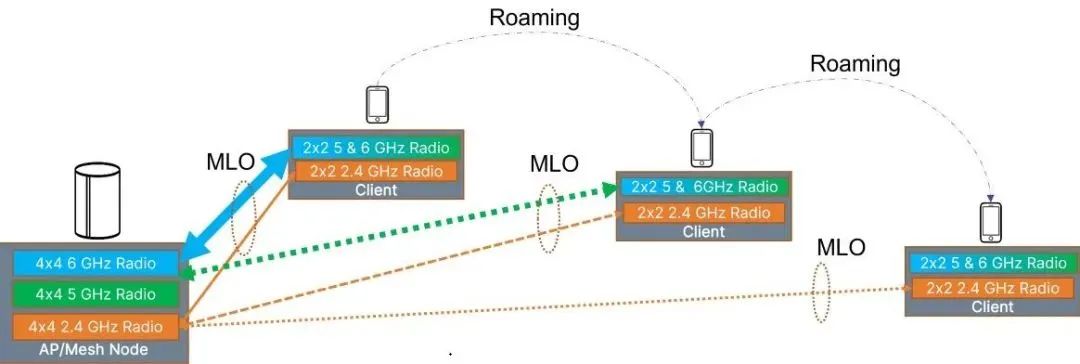
Today’s Wi-Fi 6 and 6E APs must rely on application-layer band steering or client steering features to force clients to different bands. It does not always work as expected since APs cannot control client devices; client devices decide whether to switch bands. Additionally, compatibility between vendors is another significant challenge for seamless roaming.
Higher Spectral Efficiency
In terms of spectral utilization, Wi-Fi 7 offers higher efficiency than Wi-Fi 6/6E.
Additional efficiency can benefit from various Wi-Fi 7 features, MRU, preamble puncturing, MLO, 4096 QAM, future 16 spatial streams, and coordinated multi-AP functionalities, such as coordinated beamforming, coordinated OFDMA, joint transmission, etc.
Higher Power Efficiency and Energy Savings
By utilizing higher speeds, benefiting from broader 320 MHz channel bandwidth, 4096 QAM, and lower latency, Wi-Fi 7 delivers data with higher power efficiency.
Building on the power-saving features of Wi-Fi 6, Wi-Fi 7 improves these functions in various ways to achieve optimal power savings.
With MLO, client devices do not need to listen for every Delivery Traffic Indication Message (DTIM) beacon frame, nor perform group time key, integrity group time key, or beacon integrity group time key (GTK/IGTK/BIGTK) updates.
Clients can maintain a link for DTIM beacon updates, traffic indications, and BSS key updates while keeping other links in deep sleep mode without needing to wake up regularly for DTIM beacon updates.
In addition to the most promising power-saving feature TWT in Wi-Fi 6, Wi-Fi 7 also supports a so-called trigger transmission opportunity (TXOP) sharing feature that further saves power. It allows the AP to allocate a portion of time within the acquired TXOP to associated client devices for transmission, thus the AP does not need to wake up in the next service period (SP).
Onsemi also supports many proprietary dynamic adaptive energy-saving features based on actual application, real-time throughput, and environmental (such as temperature) demands.
More Emerging Wi-Fi Sensing Applications
In recent years, Wi-Fi sensing applications, such as motion detection, positioning based on Wi-Fi Channel State Information (CSI) (especially indoors), fine time measurement/round-trip time (FTM/RTT), have garnered significant interest from service providers and end users.
Wi-Fi channels are susceptible to interference, exhibiting strong dynamics and frequency selectivity, and CSI contamination can greatly reduce the accuracy of motion detection. Thanks to the 320 MHz channel bandwidth, Wi-Fi 7 supports richer CSI data, up to 3984 tones, improving the accuracy of motion detection.
Moreover, since such a large amount of CSI data can be captured during the 320 MHz transmission, it is possible to select enough interference-free CSI blocks for motion detection while avoiding noisy CSI data.
Through 2x or 4x oversampling and upsampling techniques, for 320 MHz signals, RTT timestamps and measurement accuracy can achieve sub-nanosecond resolution. In other words, Wi-Fi 7 supports sub-meter (i.e., 30 cm) accuracy for ranging and indoor positioning, enabling many exciting new Wi-Fi sensing applications.
Conclusion
Wi-Fi 7 will significantly improve user experience in many aspects and become more cost-effective. It can enable and enhance many demanding applications such as cloud gaming, immersive AR/VR, 8K video streaming, and Industry 4.0.
Users can expect Wi-Fi 7 to provide higher speeds, lower latency, and stronger performance compared to existing Wi-Fi 6/6E.
Source: Telecom Encyclopedia, with permission for reproduction.
Recommended Reading
-
Talent Cultivation:
Huawei’s Major Products | Huawei Eagle Learning Project
-
Practical Series:
Huawei SUPER TALK | Talking About Voice
-
Technology Highlights:
History of Satellite Communication | 5GtoB | Cloud-Edge Collaboration | eSIM Cards
Metaverse | 6G | Wi-Fi6 | 5G R17 | Solid-State Drives
-
Management Secrets:
Boosting Innovation Capability | Second Track for Operators
How to Win the Gigabit Network Market | Six Elements for Strategic Implementation
-
Brand Stories:
New A Cultivation Alumni Story Meeting | Hangzhou Training Center | Gui’an Training Center
More Exciting Videos
All onHuawei Training Video Account
Give a “Collect + Like + Look” three-in-one below👇